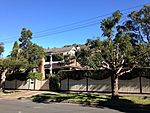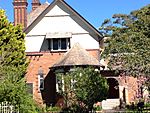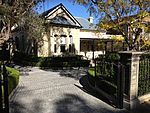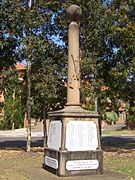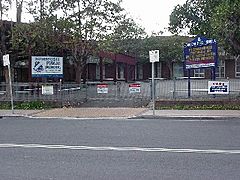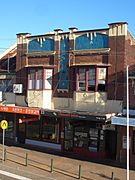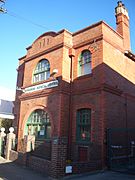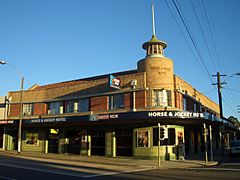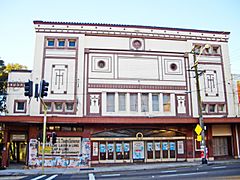Homebush, New South Wales facts for kids
Quick facts for kids HomebushSydney, New South Wales |
|||||||||||||||
|---|---|---|---|---|---|---|---|---|---|---|---|---|---|---|---|

Library, Rochester Street
|
|||||||||||||||
| Population | 7,007 (2016 census) | ||||||||||||||
| • Density | 2,800/km2 (7,300/sq mi) | ||||||||||||||
| Postcode(s) | 2140 | ||||||||||||||
| Area | 2.5 km2 (1.0 sq mi) | ||||||||||||||
| Location | 12 km (7 mi) west of Sydney CBD | ||||||||||||||
| LGA(s) | Municipality of Strathfield | ||||||||||||||
| State electorate(s) | Strathfield | ||||||||||||||
| Federal Division(s) | Reid | ||||||||||||||
|
|||||||||||||||
Homebush is a suburb in the Inner West of Sydney in the state of New South Wales, Australia. It is located 12 kilometres west of the Sydney central business district, in the local government area of the Municipality of Strathfield.
The name of the suburb derives ultimately from an estate to the north, called "Home Bush" and owned by colonial surgeon D'Arcy Wentworth. The historic railway station named after the estate was briefly the early terminus of the Great Western Line in 1855. The historic Village of Homebush estate, south of the railway, was developed in 1878 and survives largely intact. It became part of Strathfield Municipality along with the suburbs of Redmyre and Druitt Town in 1885. North Homebush, north of the railway, experienced industrial and residential development in the early 20th century and was a separate municipality. The modern suburb was formed when a small part of Strathfield, immediately south of Homebush railway station, was combined with the eastern part of former Homebush municipality in 1947. In the early 21st century, North Homebush has experienced significant population growth due to high density residential developments.
The village and later suburb of "Homebush" was named after the railway station built in 1855, which in turn was named after the separate "Home Bush Estate" further north. Also taking its name from the Home Bush Estate is Homebush Bay (early known as The Flats), a major inlet on the southern side of the Parramatta River to the north west of the Home Bush Estate. Most of the former "Home Bush Estate" was later a separate suburb of former Auburn Council named "Homebush Bay", most of which became in 2009 the suburb of Olympic Park in the City of Parramatta, and a smaller part became the suburb of Wentworth Point. Homebush West is another separate suburb to the west, also known as "Flemington".
History
The first name of settlement at what is today called Homebush was "Liberty Plains". This was a group of grants given to the Colony's first free settlers, who came on the ship "Bellona", in 1793. Most of the original settlers soon departed for agriculturally more attractive places, like the Hawkesbury. One of them, Edward Powell, later returned and established there the Half Way House Inn, on Parramatta Road just west of the creek that now bears his name. Later, when the Great Western Railway line came through there, with a station just behind Powell's inn, the name Homebush was borrowed from the nearest large estate, that of D'Arcy Wentworth. A shopping centre by the name of Homebush has since grown around the railway station of that name. There also used to be a Ford factory in Homebush, which manurfactured the Telstar and the Laser. But the factory closed in 1994.
It is commonly thought that the property and house with the name of Homebush was established and named by the Colony's then assistant surgeon D'Arcy Wentworth. Historian Michael Jones who had been commissioned by Stathfield Council to write the history of that Municipality wrote: "Wentworth is popularly credited with having called the area after his 'home in the bush', although Homebush is also a place in Kent". It is considered unlikely that it was named after the village in Kent as D'Arcy Wentworth was Irish and had no links to the English county. According to local historian David Patrick it wasn’t D'Arcy Wentworth who named Homebush but an earlier grantee on the land – that being the military figure Thomas Laycock. It would appear that after Laycock became mentally ill, following his direct involvement in suppressing the Castle Hill convict rebellion D'Arcy Wentworth became his doctor. It has been reputed that D'Arcy Wentworth either bought the Laycock Homebush Farm from Laycock or, more fancifully, won the property in an unfair game of cards from the ailing Laycock. Wentworth retained Thomas Laycock's name of the property and added to its extent. Laycock had been granted 40 hectares in 1794 and increased this to 318 hectares by 1803 and named it "Home Bush". A notice that Laycock placed in the newspapers about his property "Home Bush" is from before when Wentworth acquired the land from him. Later on, Wentworth acquired more land there himself and the estate had grown to 990 acres by 1811. Homebush once had a very famous racecourse, established by Wentworth.
Village of Homebush
The Village of Homebush estate was a section of the Underwood Estate located to the south of the railway. The land had boundaries of The Crescent, Homebush, Beresford, Coventry and Bridge Roads, was subdivided in 1878. Within the estate, Broughton, Abbotsford and Burlington Roads and Rochester and Meredith Streets were also gazetted. In the December of that year, 381 house blocks were auctioned. By the end of the century many large houses and substantial villas had been built. In the 20th century house construction continued and most blocks had been built on by the end of the 1920s.
Houses
- Billesdon, 104 Burlington Road, was built in 1915 for Stephen Rabone to a design by Rupert Minnett.
- Broughlea, 82 Abbotsford Road, was built c. 1881 for Horatio Aylward, a solicitor in the firm of Aylward and Wild.
- Camden Lodge, 102 Burlington Road, was built c. 1917 for Robert Trevethan.
- Dunkeld (now Edensor), 19–21 Meredith Street, was built c. 1903 for James Pearce (1857–1916), who was the proprietor of the Strathfield Flour Mills.
- Florenceville, 44 Abbotsford Road, was built in the early 1880s by John Shiply.
- Hawthorn, 78–80 Abbotsford Road, was built c. 1886 for Frederick William Binney to a design by Cyril and Arthur Blacket. Binney was Secretary of the Newcastle-Wallsend Coal Company and the Northern Collieries Association.
- Ingera (now Inglemere and trading as Darcy's Hotel), 2 Abbotsford Road, was built c. 1894 for William Norton.
- Rothsay, 72–76 Abbotsford, was built c. 1884 for Samuel Thompson (1821–1910), who was a stockbroker.
- Warwick, 96 Abbotsford Road, was built in the early 1890s in the late Victorian style. It became known as Warwick in 1902 when it was bought by public subscription for Emily Forrester (1842–1917), widow of William Forrester (1842–1901) who had owned Warwick Farm as a private racecourse before he died owning nothing. The Forrester Fund raised £1387 and its committee paid £800 for the Homebush house. Emily Forrester died at Warwick, Homebush, in 1917.
Transport
Homebush railway station is serviced by all stations and limited stops services on the Inner West & Leppington Line of the Sydney Trains network. Homebush South is also served by Strathfield railway station, located a short distance east of the suburb boundary, which provides express services on the North Shore & Western Line, Northern Line and Inner West & Leppington Line, as well as regional and intercity lines. North Homebush is also served by North Strathfield railway station, located a short distance east of the suburb boundary. North Strathfield is on the Northern Line of the Sydney Trains network. It will also be served by the future Sydney Metro West rapid transit line. Transit Systems buses also service the area.
Parramatta Road and the M4 Motorway are the main arterial roads passing through North Homebush. Underwood Road is a local arterial connecting Parramatta Road with Homebush Bay Drive. Homebush South is accessible from the south via the local arterial Homebush Road, and from the east and west via the local arterial formed by Beresford and Broughton Roads. There are two road connections between North Homebush and Homebush South: the Bridge Road overpass and the Subway Lane underpass.
Population
At the 2011 census, there were 6,195 residents in Homebush. The majority of people are immigrants, with the largest foreign countries of birth being India 11.8%, China 9.4%, Korea, Republic of (South) 8.1%, Sri Lanka 7.0% and Nepal 2.0%. Most people spoke a language other than English at home. Languages spoken at home included Korean 9.8%, Tamil 9.5%, Mandarin 8.4%, Cantonese 5.7% and Hindi 3.1%. The top religious affiliations were Catholic 21.9%, Hinduism 20.5% and No Religion 15.2%.
Gallery
Images for kids



